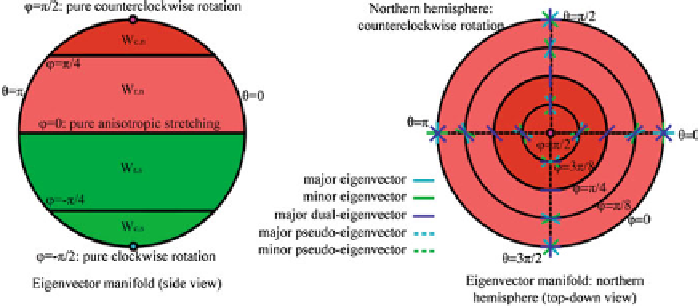Image Processing Reference
In-Depth Information
the real domains into complex domains. Dual-eigenvectors are also the semi-axes of
the elliptical flow patterns inside the complex domains.
Zhang et al. [
28
] realize that the decomposition from Eq. (
14.3
) can be simplified
and reparameterized as follows:
cos
0
θ
sin
θ
1
10
−
T
(ρ,θ,ϕ)
=
ρ
cos
ϕ
+
ρ
sin
ϕ
(14.4)
sin
θ
−
cos
θ
s
is the tensor magnitude. Notice that
D
, the isotropic scaling
component, does not impact the directional information in a tensor field and can
be dropped when considering eigenvectors. Furthermore,
r
where
ρ
=
γ
+
γ
(γ
s
,γ
r
)
is considered as a
vector since it is their respective strength that determines whether a tensor is in the
real domain or complex domain, the angle between the major and minor eigenvectors
in the real domain, and the eccentricity of the elliptical flow patterns in the complex
domain. Similar to the definition of eigenvalue manifold, Zhang et al. define the
eigenvector manifold by considering unit vectors, i.e.,
r
s
1. Such tensors
can be parametrized using spherical coordinates shown in Eq. (
14.4
). Zhang et al. [
28
]
demonstrate that a tensor is in the real domain if
γ
+
γ
=
−
4
<φ<
4
and complex domain
φ<
−
4
φ>
4
. The equator (
if
or
φ
=
0) corresponds to the pure shearing
φ
=±
2
) correspond to pure rotations (degenerate points
in the tensor). The boundary between the real and complex domains (
tensors while the poles (
φ
=±
4
)is
referred to
degenerate curves
. Points on these curves correspond to
simple shears
which are different from pure shears. Notice that equator serves as the boundary
between counterclockwise rotating flows and clockwise rotating flows. Figure
14.11
illustrates these facts, while Fig.
14.12
demonstrates some special configurations.
Fig. 14.11
Eigenvector manifold: the orientation of the rotational component is counterclockwise
in the northern hemisphere and clockwise in the southern hemisphere. Each hemisphere is par-
titioned into real domains and complex domains. The equator represents pure symmetric tensors
(irrotational flows), while the poles represent pure rotations. The directions of expansions and con-
traction in the real domain as well as the orientations of the elliptical patterns are determined by the
relative stretches between the rotation and stretching components in the decomposition [
28
]. © IEEE
Reprinted, with permission, from IEEE Transactions on Visualization and Computer Graphics 15(1)








Search WWH ::

Custom Search